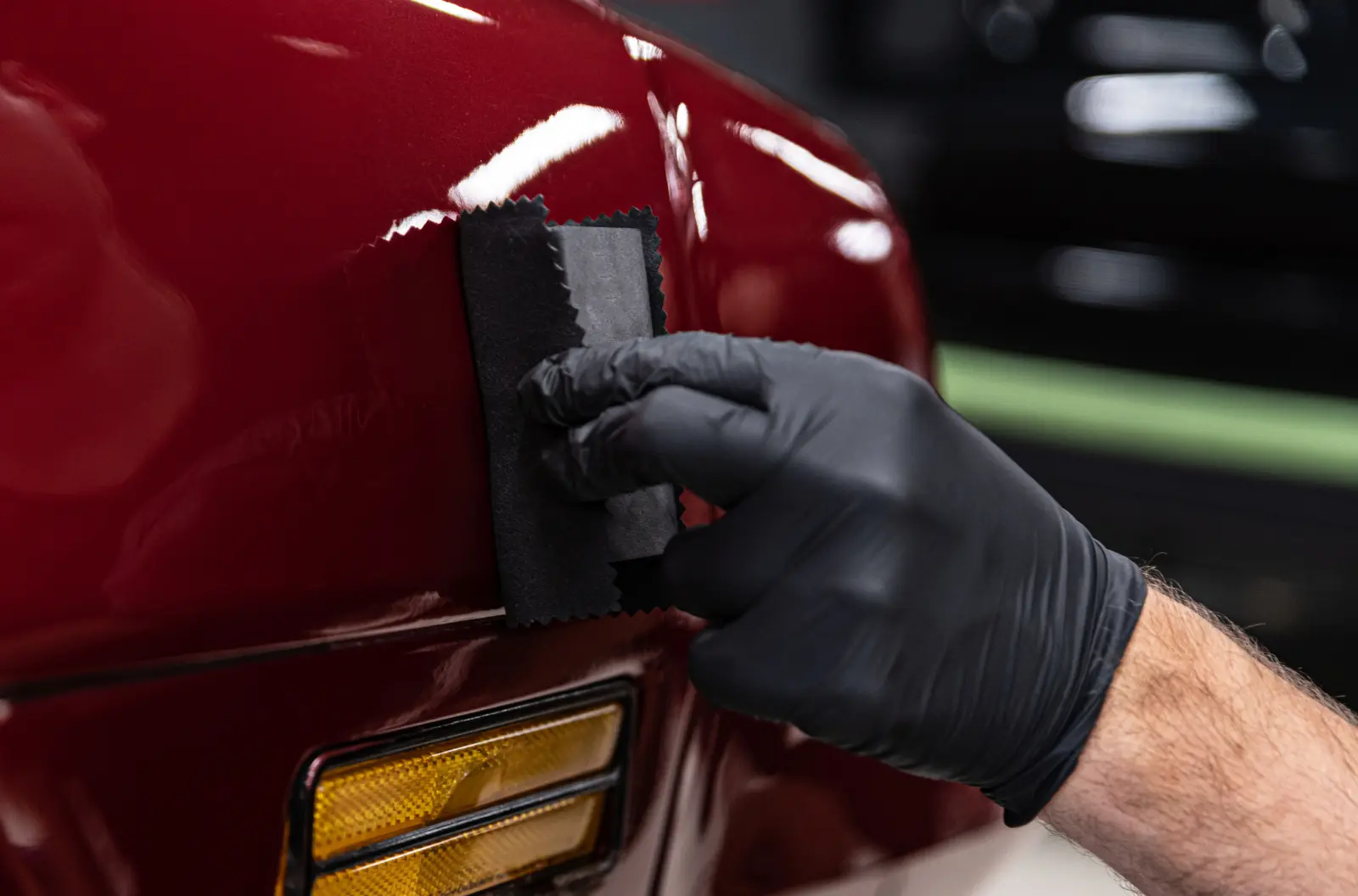Ceramic coating is a liquid polymer that is applied to surfaces, particularly automotive exteriors, to create a protective layer. This coating chemically bonds with the surface, providing a durable and resilient shield.
Ceramic coatings are primarily composed of silicon dioxide (SiO2) or titanium dioxide (TiO2). These compounds are typically derived from natural sources such as quartz or sand. When applied to a surface, these compounds form a liquid polymer that cures to create a hard, protective layer. The chemical structure of these coatings allows them to fill in microscopic imperfections, resulting in a smooth, seamless finish that enhances both protection and appearance.
At a molecular level, ceramic coatings work by forming a lattice-like structure that bonds with the surface it is applied to. This bonding process creates a strong, semi-permanent layer that is highly resistant to environmental contaminants. The coating’s hydrophobic properties mean that it repels water and other substances, preventing them from adhering to the surface. This not only protects the underlying material from damage but also makes it easier to clean and maintain.
Ceramic coatings come in various formulations, each designed to offer specific benefits and suit different applications. Here are the primary types:
TiO2-based coatings are known for their superior durability and are often used in industrial applications. These coatings are highly resistant to extreme temperatures and harsh chemicals, making them ideal for protecting machinery, equipment, and surfaces exposed to severe environmental conditions. They also have self-cleaning properties, breaking down organic materials upon exposure to sunlight.
Hybrid ceramic coatings combine the properties of SiO2 and TiO2 to offer enhanced performance. These coatings provide the high-gloss finish and chemical resistance of SiO2, along with the durability and self-cleaning properties of TiO2. Hybrid coatings are versatile and can be used in both automotive and industrial applications.
A newer addition to the market, graphene-based coatings offer excellent durability and thermal conductivity. They are known for their outstanding protective properties, including resistance to scratches, chemicals, and high temperatures. Graphene coatings also enhance the surface’s gloss and hydrophobicity, making them a premium option for high-end applications.
Polymer-based ceramic coatings provide good protection and ease of application. While not as durable as SiO2 or TiO2 coatings, they still offer a solid barrier against UV rays, chemicals, and minor abrasions. These coatings are often more affordable and easier to apply, making them suitable for consumer products and entry-level automotive protection.
Each type of ceramic coating has its unique advantages, making it important to choose the right one based on the specific needs of the application.
Paint Protection: Ceramic coatings provide a strong protective layer over automotive paint, shielding it from UV rays, chemicals, bird droppings, and minor scratches. This helps maintain the vehicle’s original appearance and reduces the need for frequent waxing or polishing.
Interior and Exterior Surfaces: Beyond paint, ceramic coatings are also applied to wheels, glass, and interior surfaces. They protect against contaminants, make cleaning easier, and enhance the overall look of the vehicle by providing a glossy finish.
Machinery and Equipment: In industrial settings, ceramic coatings protect machinery and equipment from wear, corrosion, and chemical exposure. This extends the lifespan of the equipment and reduces maintenance costs. These coatings are especially beneficial in harsh environments where machinery is exposed to extreme conditions.
Marine and Aerospace Industries: Ceramic coatings are crucial in marine and aerospace industries due to their resistance to saltwater, high temperatures, and harsh weather conditions. They protect ship hulls, aircraft bodies, and other components, ensuring longevity and optimal performance.
Electronics: Ceramic coatings are used on electronic devices to protect screens and casings from scratches and wear. This enhances the durability and aesthetic appeal of gadgets like smartphones, tablets, and laptops.
Household Items: From kitchen appliances to bathroom fixtures, ceramic coatings provide a durable, easy-to-clean surface. They protect against stains, scratches, and corrosion, keeping items looking new and extending their usability.
In summary, ceramic coatings play a significant role in enhancing the durability, appearance, and maintenance of various products across multiple industries. Their application ranges from automotive and industrial machinery to everyday consumer electronics and household items, showcasing their versatility and effectiveness.
High Durability: Forms a hard, protective layer lasting several years.
Extended Lifespan: Reduces the need for frequent reapplication, ensuring longevity.
UV Protection: Prevents paint from fading due to sun exposure.
Chemical Resistance: Shields surfaces from stains and corrosion caused by chemicals.
Oxidation Resistance: Protects against the damaging effects of oxidation.
Hydrophobic Properties: Repels water, dirt, and contaminants.
Reduced Cleaning Effort: Makes surfaces easier to clean and maintain, saving time and effort.
High-Gloss Finish: Provides a sleek, glossy look, enhancing visual appeal.
Sophisticated Appearance: Adds a layer of sophistication and value to the coated item.
Myth: Ceramic coatings make surfaces scratch-proof.
Fact: While ceramic coatings provide a hard, protective layer, they are not completely scratch-proof. They offer resistance to minor scratches but can still be damaged by significant impacts.
Myth: Ceramic coatings eliminate the need for maintenance.
Fact: Ceramic coatings make surfaces easier to clean and maintain, but they still require regular washing and care to remain effective.
Myth: All ceramic coatings are the same.
Fact: There are various types of ceramic coatings with different formulations and properties. Choosing the right type based on the specific application is crucial for optimal performance.
Ceramic coatings are highly effective at protecting surfaces from environmental damage, including UV rays, chemicals, and oxidation. However, they are not a one-size-fits-all solution and should be selected based on the specific needs of the application.
Regular maintenance is essential to keep ceramic coatings effective. This includes periodic washing and occasional reapplication of the coating to ensure long-term protection and performance. Proper care will maximize the benefits and longevity of the ceramic coating.
Quality: Higher quality coatings offer better protection and durability. Look for products with a high concentration of active ingredients like SiO2 or TiO2.
Brand Reputation: Choose reputable brands known for their reliable and effective coatings. Customer reviews and professional endorsements can be helpful.
Application Method: Consider whether you will apply the coating yourself or hire a professional. DIY kits are available but professional application often ensures better results and longevity.
Automotive Use: SiO2-based coatings are ideal for protecting car paint and providing a high-gloss finish.
Industrial Applications: TiO2-based coatings are suitable for machinery and equipment due to their superior durability and resistance to harsh conditions.
Consumer Products: Hybrid coatings or graphene-based coatings offer excellent protection and aesthetic enhancement for electronics and household items.
Selecting the appropriate ceramic coating based on these factors and use cases will ensure optimal performance and protection.
Ceramic coatings offer exceptional protection and enhancement for various surfaces. They provide durability, resistance to environmental damage, ease of maintenance, and a high-gloss finish. Choosing the right coating involves considering factors like quality, brand reputation, and application method. By selecting the appropriate type for each use case, whether automotive, industrial, or consumer products, you can ensure long-lasting protection and aesthetic improvement. Ceramic coatings are a valuable investment, enhancing the longevity and appearance of your assets. Explore our range of products to find the perfect solution for your needs.





